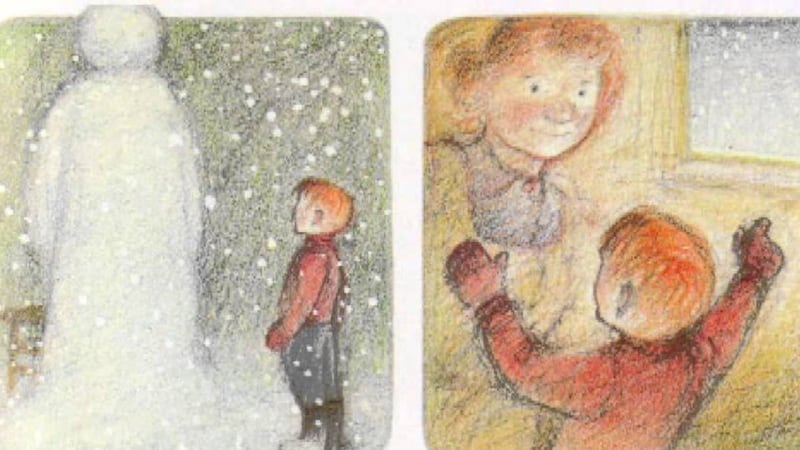Raymond Briggs, the writer and illustrator who delighted children and inspired adults with best-selling cartoons and picture books, has died aged 88, his publisher Penguin Random House has said.
Ranging from the enchanting magic of The Snowman to a devastating apocalypse in When the Wind Blows, Briggs created a host of much-loved characters including his angst-ridden Fungus the Bogeyman and his curmudgeonly version of Father Christmas. A career spanning six decades brought him numerous awards, with television adaptations making him a fixture of Christmas viewing.
Born in 1934, Briggs went to the local grammar school in Wimbledon. His decision to leave school at 15 to go to Wimbledon Art College may have puzzled his milkman father, but he was not dreaming of becoming Michelangelo.
“I never thought about being a gold-framed gallery artist and was only pushed into painting when I went to art school,” he said in 2004. “I went there wanting to do cartoons.”
Briggs’s interest in commercial art was met with horror at college — one teacher spluttering, “Good God, is that all you want?” — and after national service Briggs met more snobbery while studying at the Slade School of Fine Art. But when he left at 23, his talent for drawing realistic images from memory meant it was not hard to find work as an illustrator for magazines, advertisers and books.

As the 1960s dawned, Briggs had begun to despair at the quality of the books he was illustrating. “They were so bad that I knew I could do better myself,” he said “so I wrote a story and gave it to an editor hoping he would give me some advice. But instead he said he would publish it, which shows what the standard was like if a complete novice who had never written anything more than a school essay could get his first effort published.”
The Strange House was published in 1961 and five years later, his 800 illustrations for an edition of The Mother Goose Treasury won him the prestigious Kate Greenaway medal. Jim and the Beanstalk, a warmhearted sequel to the traditional tale, came in 1970.
In 1973, he won a second Kate Greenaway medal and a wider audience with Father Christmas. This 24-page strip cartoon imagines Santa Claus as a grumpy old man, grumbling his way through his busiest day of the year: Christmas Eve. We follow him as he wakes up — “Blooming Christmas here again!” — and sets off on his round, the sparse dialogue a litany of complaints about “Blooming aerials”, “Blooming cats”, “Blooming soot”, “Blooming chimneys” and all the “Stairs, stairs, stairs”.
Speaking in 2014 about his best-seller, Briggs said, “He’s been doing this dreadful job for donkeys’ years: going out all night long, in all weathers. He’s sick to the back teeth of it: who wouldn’t be? So it follows, naturally, that he’s going to be grumpy.”
The same spirit infused Briggs’s 1977 Fungus the Bogeyman, which imagined Fungus living in dank, smelly tunnels evoked in a palette of mud brown and acid green. Heading out at night to frighten people on the surface, Fungus ponders the futility of existence: “There must be more to life than this.” The Guardian declared it suitable “for children over the age of 10 — or adults — with murky minds and horrid senses of humour”, while the Times called it “the ideal picture book for an age of punk rock and general glorification of ugliness”. It sold 50,000 copies within a year.
Briggs turned next to pastels in 1978’s The Snowman, a wordless story about a boy whose snowman comes to life. But this magical story was still grounded in harsh reality; the next morning, the boy wakes to find only the snowman’s hat and scarf listing on a pile of melting snow. “I don’t have happy endings,” Briggs told the Radio Times in 2012. “I create what seems natural and inevitable. The snowman melts, my parents died, animals die, flowers die. Everything does. There’s nothing particularly gloomy about it. It’s a fact of life.”
Channel 4 didn’t duck the issue with its 1982 animated version, but sugared the pill by adding a visit to Father Christmas and a soundtrack with a piping choirboy. Despite acknowledging the need for a film to be commercially viable, Briggs told the Guardian in 2015 that he hated it at the time and still found it corny. But the animation became a fixture on festive TV schedules, lending Briggs a Christmassy reputation that only grew after television versions of Father Christmas in 1991 and Fungus the Bogeyman in 2004 and 2015.
Meanwhile, Briggs turned away from fantasy, with picture books tackling nuclear war (When the Wind Blows), the British invasion of the Falklands (The Tin-Pot Foreign General and the Old Iron Woman) and an account of his parents’ marriage (Ethel and Ernest). But he rejected the idea that his work was divided into books for adults and books for children.
“There are a few books which are obviously for small children,” he told the Guardian in 1999, “but I don’t usually think about whether a book is for children or adults. After a child has learned to read fluently, at about eight or nine, then the whole idea of categorising them seems a bit daft.”
Time for Lights Out, a “hotchpotch” of drawings, verse, memories quotations Briggs worked on for a decade, looks death square in the face. In it, he imagines “future ghosts” looking around his house in Sussex: “There must have been / Some barmy old bloke here,” he writes, “Long-haired, artsy-fartsy type, / Did pictures for kiddy books / Or some such tripe. / You should have seen the stuff / He stuck up in that attic! / Snowman this and snowman that, / Tons and tons of tat.” — Guardian

